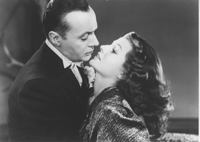Tales of Manhattan (US 1941/42)

Inhalt
Episodenfilm um einen Frack, der mehrfach die Besitzer wechselt und deren Leben eine Wendung gibt: Da wird ein Schauspieler, dessen Spezialität Todesszenen sind, vom Ehemann seiner Geliebten angeschossen. Ein untreuer Bräutigam bittet einen Freund, seine Braut zu überzeugen, dass nicht er, sondern der Freund der Adressat eines im Frack gefundenen Liebesbriefs sei. Ein Musiker bekommt die große Chance, seine Komposition zu dirigieren, doch der geliehene Frack erweist sich als zu eng und die Nähte reißen, sehr zum Amüsement des Publikums. Mit dem in einer Mission für Arme abgegebenen Frack kann ein obdachloser Rechtsanwalt, dem das Schicksal schwer mitgespielt hat, das 25-jährige Jubiläum seiner Jura-Klasse besuchen. Schließlich wird der Frack aus einem Second-Hand-Laden von einem Ganoven entwendet, der in einem Spielcasino 50.000 Dollar stiehlt. Als er mit einem kleinen Flugzeug flieht, gerät der Frack durch einen Funken in Brand und wird von dem Dieb kurzerhand – samt Geld – über Bord geworfen. Er landet mitten in einer Siedlung von afroamerikanischen Farmern, die sich mit dem Geld ihre Träume erfüllen. Der Frack findet Verwendung als Vogelscheuche.
Kritiken
A series of short stories revolving around the adventures of a gentleman’s tailcoat, interpreted by a roster of stars that reads like a “Who’s Who” of film circles, has resulted in a picture of many moods, but whatever the mood, it is at all times entertaining. The clever screen play, in which no less than ten writers took a hand, is so formulated as to allow the individual talents of the stars to be displayed to the best advantage, each one cast in a leading role. From the time the coat first drapes the shoulders of a matinee idol, until it ends up as a scarecrow on a sharecroppers’s farm, one’s interest in the proceedings never fades. It is by turns suspensive, heart-warming, tragic, and comical. Capably directed and effectively performed, it should prove to be one of the year’s top box-office pictures.
“Tales of Manhattan” with an all star cast
Harrison’s Reports (New York), 8.8.1942
TALES OF MANHATTAN is one of those rare films – a tricky departure from the norm, which, in spite of its five-ring-circus nature, achieves an impressive effect. Neither profound nor very searching, it nevertheless manages to convey a gentle, detached comprehension of the irony and pity of life, and it constantly graples one’s interest with its run of assorted incidents. The big surprise is that its actors never dwarf the little fables they play and that the whole film never exposes the rather fragile framework on which it is built. […]
If the various episodes are not consistent with this theme – all of them, that is – and if the concluding incident is strangely remote from those which have gone before, the fault may be charged to the fact that the film was written in parts and the various authors were not wholly aware of the central idea. But this weakness of structure does not prevent the episodes themselves from being intriguing, and the eventual destination of the dress suit a teaser for sustaining suspense. […]
Edward G. Robinson gives a masterful performance as the bum who had seen better days; Ginger Rogers and Henry Fonda are very amusing in the romance-switching episode, and Roland Young, James Gleason and George Sanders stand out in minor roles. Charles Boyer, Rita Hayworth and Thomas Mitchell are somewhat heavy in the initial triangle and Charles Laughton overplays the pianist who gets his big chance to rise.
But, altogether, Julien Duvivier has directed the film with surprising evenness and has matched the moods and tempos of the various episodes with delicacy. Much of the credit for this picture must go to him, and a good bit more must go to Borris Morros and S. P. Eagle, who persuaded Twentieth-Century-Fox to make it. The venture was obviously risky, but the result is sufficient recompense.
Bosley Crowther: Tales of Manhattan
The New York Times, 25.9.1942